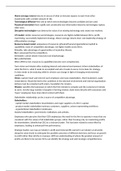Above-average returns=returns in excess of what an investor expects to earn from other
investments with a similar amount of risk.
Technological diffusion=the rate at which new technologies become available and are used.
Perpetual innovation=how rapidly and consistently new information-intensive technologies replace
older ones.
Disruptive technologies=can destroy the value of an existing technology and create new markets.
I/O model: similar resources and strategies, resources are highly mobile between firms, profit-
maximizing, successfully implement strategy. Above-average returns door cost leadership strategy of
differentiation strategy.
Resource-based model: uniqueness of resources (physical/human/organizational capital) &
capabilities, basis of competitive advantage, not highly mobile across firms.
Valuable: take advantage of opportunities of neutralize threats.
Rare: possessed by few competitors.
Inimitable: cannot obtain resources/cost disadvantage.
Non-substitutable.
When VRIN is met, resources & capabilities become core competencies.
Form vision and mission after studying internal and external environment: inform stakeholders of
what the firm is, what it seeks to accomplish and who it seeks to serve. Form basis for strategy.
A vision tends to be enduring while its mission can change in light of changing environmental
conditions.
Vision: capture heart and mind of each employee and many stakeholders. Short statement, easily
remembered. Should be tied to the conditions in the external environment and internal organization.
Actions must be consistent with vision. Foundation for mission.
Mission: specifies the businesses in which the firm intends to compete and the costumers it intends
to serve. Involve large number of people in forming mission; deals more directly with consumers and
‘lower’ employees have more direct contact with them.
Stakeholder relationship can be a source of competitive advantage.
Stakeholders:
- capital market stakeholders=shareholders and major suppliers of a firm’s capital.
- product market stakeholders=primary customers, suppliers, unions representing workforce.
- organizational stakeholders=employees.
Societal stakeholders: government, institutions and activists.
Employees who perceive that their CEO emphasizes the need for the firm to operate in ways that are
consistent with the values of all stakeholder groups, rather than focusing only on maximizing profits
for shareholders, identify that CEO as a visionary leader. This has been related to extra effort by
employees, leading to enhanced firm performance.
Strategic leaders can map an industry’s profit pool (total profits earned in an industry at all points
along the value chain) to anticipate the possible outcomes of different decisions and focus on growth
in profit rather than strictly in revenues. With an understanding of where the greatest amount of
profits are likely to be earned, firms can identify the strategy and seek strategic competitiveness.
,3 parts of external environment:
General environment: demographic, economic, political/legal, socio-cultural, technological, physical
and global.
Industry environment: 5 forces.
Competitor environment: predict actions, responses and intentions.
External environmental analysis: scanning, monitoring, forecasting and assessing.
Boundary-spanning positions: salespersons, costumer services etc. interact with external
constituents.
Scanning: study of all segments in the general environment -> identify early signals of
potential/underway changes. Reveals incomplete information.
Monitoring: observe environmental changes to see if an important trend is emerging from among
those spotted through scanning.
Forecasting: develop projections of what might happen, and how quickly, as a result of the changes
and trends detected through scanning and monitoring.
Assessing: determine the timing and significance of the effects of environmental changes and trends
that have been identified. Interpreting information is more important than gathering.
Recognize opportunities and threats.
Demographic segment: population size, age structure, geographic distribution, ethnic mix, income
distribution.
Economic segment.
Political/legal segment.
Socio-cultural segment.
Technological segment.
Global segment.
Physical segment: environment/ecologie/duurzaamheid.
Threat of new entrants
Entry barriers:
- economies of scale -> small firm cost disadvantage, big firm competitive retaliation.
- product differentiation -> “unique” product, loyal costumers.
- capital requirements.
- switching costs.
- access to distribution channels.
- cost disadvantages independent of scale (good location, subsidies).
- government policy.
Expected retaliation: slow industry growth/firm has major stake in industry/substantial resources.
Bargaining power of suppliers
- suppliers are more concentrated than the industry they sell to.
- substitute products are not available.
- suppliers do not depend heavily on the industry for its revenues.
- suppliers’ goods are critical.
- high switching costs.
- supplier can credibly threat to integrate forward (resources and differentiated product).
Bargaining power of buyers
- there are large volume buyers.
- buyers face low switching costs.
- there are few buyers.
, - the product is undifferentiated.
- the sales of the product account for a significant portion of the seller’s revenues.
Threat of substitute products
Same function, different industry.
- low switching costs.
- lower price/higher quality.
Intensity of rivalry among competitors
- numerous/equally balanced competitors.
- slow industry growth.
- high fixed costs, low marginal costs -> overcapacity, lower prices.
- perishable products.
- lack of differentiation or low switching costs.
- high strategic stakes -> important to perform well in the market/geographic location.
- high exit barriers: specialized assets, contracts, relationships of mutual dependence, loyalty to
employees, government and social restrictions (job losses).
Intra-strategic group competition (binnen) is more intense than inter-strategic (buiten).
What drives the competitor? Future objectives.
What is the competitor doing and can do? Current strategy.
What does the competitor believe about the industry? Assumptions.
What are the competitors capabilities? Strengths and weaknesses.
Complementors (also alliances) and public policies.
Must obtain competitor intelligence in a legal and ethical way. Prevent competitors to learn too
much about your firm as well.






